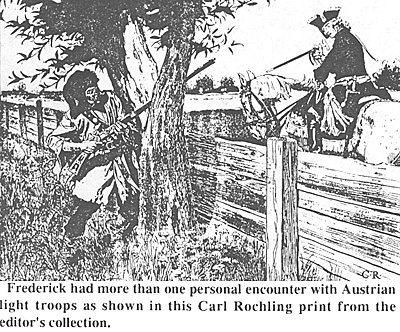 One of the most audacious of the type of 'small wars' was the Austrian attempt to capture Frederick the Great at Baumgarten in Silesia 1741. Though an insignificant affair in terms of the numbers involved, Baumgarten was an action where the fate of the entire Prussian war effort hung in the balance. It is interesting to speculate on the course of history if the Austrian plan had been successful and the king captured or even killed. It seems likely that the Prussians would have been driven out of Silesia and Prussia's development as a major power postponed, perhaps indefinitely.
One of the most audacious of the type of 'small wars' was the Austrian attempt to capture Frederick the Great at Baumgarten in Silesia 1741. Though an insignificant affair in terms of the numbers involved, Baumgarten was an action where the fate of the entire Prussian war effort hung in the balance. It is interesting to speculate on the course of history if the Austrian plan had been successful and the king captured or even killed. It seems likely that the Prussians would have been driven out of Silesia and Prussia's development as a major power postponed, perhaps indefinitely.
Frederick had more than one personal encounter with Austrian light troops as shown in this Carl Rochling print from the editor's collection.
Background to the Action
Following his successful surprise attack on the Austrian province of Silesia in December 1740, Frederick the Great returned to Berlin on January 25. Three small Austrian detachments still held out in the fortresses of Brieg, Glogau and Neisse and were blockaded by the bulk of the Prussian invasion force. Other than a small garrison in the Silesian capital, Breslau, the remaining Prussins were scattered along the border and in Upper (i..e. southern) Silesia at Troppau and Jagerndorf to watch the buildup of Austrian relief forces across the mountains. These were slowly collecting in Moravia, but had advance posts in northeast Bohemia and the County Glatz under Major General Baron Lentulus. (see Appendix).
Lentulus was instructed to make life difficult for the Prussians until the main Austrian army had collected. Raids were launched over the mountains to disrupt the Prussian communications and create diversions so that reinforcements and supplies could be smuggled into the beleaguered fortresses. At this stage, only three hussar regiments were available for such activity. The Austrian Grenzer irregulars who later were to cause the Prussians such problems had not yet fully mobilized and reached the war zone. However, the Austrians were assisted by the fact that the Prussians were operating in hostile territory.
The peasants of Upper Silesia and Moravia were Catholics whose hatred of the Protestant invaders was soon roused by the firey sermons of their priests as well as by the Prussian's habit of requisitioning supplies without payment. Those people who showed signs of cooperating with the invaders were terrorized by the Austrian hussars, while the besieged commander of Neisse sallied forth to kidnap pro-Prussian nobility. Although the hussars probably numbered no more than 1,500 effectives, they were more than a match for the Prussians who had little experience in this kind of warfare. This became painfully obvious during the skirmish at Baumgarten which nearly resulted in the capture of the Prussian king.
Frederick had left Berlin on February 19, 1741 to inspect his army in Upper Silesia. By the 22nd he had reached Leignitz, from where he intended to visit the outposts near the Silberberg and Reichenbach passes before going on to Jagerndorf to consult with Field Marshal Schwerin. This was highly dangerous. The Prussian forces were very thin on this ground and they had no clear idea of the enemy's strength or position. There had already been skirmishes in the area and Schwerin wrote to the king warning him of danger. However, Frederick was determined that his forces remain in Upper Silesia until Glogau and the other Austrian fortresses had been captured. He knew of the Austrian buildup, but wanted to consult with Schwerin before taking any action.
The Austrian Plans
In contrast, Lentulus was well informed of the king's whereabouts and intentions. Field Marshal Seckendorf, an accomplished intriguer, had learned of the king's movements from contacts that he had made during his time as Austrian ambassador in Berlin [1]. He now wrote to Lentulus from Vienna suggesting a plan to capture Frederick when he arrived at Frankenstein on his way to the outposts. The letter reached Lentulus on February 25, 1741 and he immediately despatched his hussars to sieze the king. However, Frederick never appeared and they had to return the next day empty handed. Then definite news arrived that Frederick intended to visit the isolated post at Wartha on the 27th. Lentulus immediately ordered Colonel Baron Adolph Trips to make another attempt.
Frederick was known to have only a small escort and Trips decided to surprise him with his Splenyi Hussars. Two detachments of sixty men each were sent to the village of Briesnitz, north of the Neisse river, to cut off the king's retreat, while Trips and another thirty men rode to Johnsbach, south of the river, to sieze the king.
Alte Fritz's Narrow Escape At Baumgarten February 27, 1741
- Introduction
The Action Begins
Appendix: Position of the Opposing Forces on February 20, 1741
Jumbo Baumgarten Map (very slow: 237K)
Back to Seven Years War Asso. Journal Vol. VIII No. 4 Table of Contents
Back to Seven Years War Asso. Journal List of Issues
Back to Master Magazine List
© Copyright 1996 by James E. Purky
This article appears in MagWeb.com (Magazine Web) on the Internet World Wide Web.
Other articles from military history and related magazines are available at http://www.magweb.com